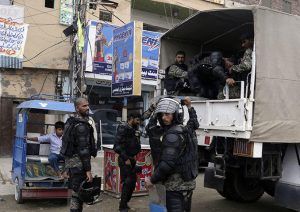Report from Committee to Protect Journalists:

When CPJ traveled to Karachi, Islamabad, Peshawar, Lahore, and Okara earlier this year, journalists, including freelancers and those from established media companies, painted a picture of a media under siege. Many traced the changes to two events in 2014: a shooting that injured Geo TV anchor Hamid Mir and led to a fallout among media groups and with the military, and the aftermath of a terrorist attack in Peshawar that left over 130 students dead. The military garnered widespread praise for its crackdown on militancy after the school attack, which resulted in a sharp decline of terrorist incidents—and in turn, violence against journalists. Yet the stepped-up activity put the military in position to exert even greater control. The military already wields influence and power in Pakistan, where it is deeply embedded in society, as well as the country’s economic and political systems.
The armed forces are seen widely as an effective institution that holds the nation together, and offers protection. To the east, Pakistan faces India, a far larger and powerful neighbor that is considered hostile, and with whom it has a territorial dispute over Kashmir. To the west is Afghanistan, unstable and with a porous, mountainous border that creates obstacles to security. Internationally, the U.S. has used Pakistan as a staging area for operations in Afghanistan, even as it launches drone strikes against militants on Pakistani territory—an issue of nationalist ire. While the military submits to the formalities of civilian rule, it sees itself as a bulwark against what some view as the chaos of democratic politics. But it remains sensitive to criticism or allegations, such as its apparent support for terrorist groups in neighboring countries, including the Afghan Taliban and Lashkar-e-Taiba, which is accused of staging the 2008 Mumbai terrorist attack.
More here.
